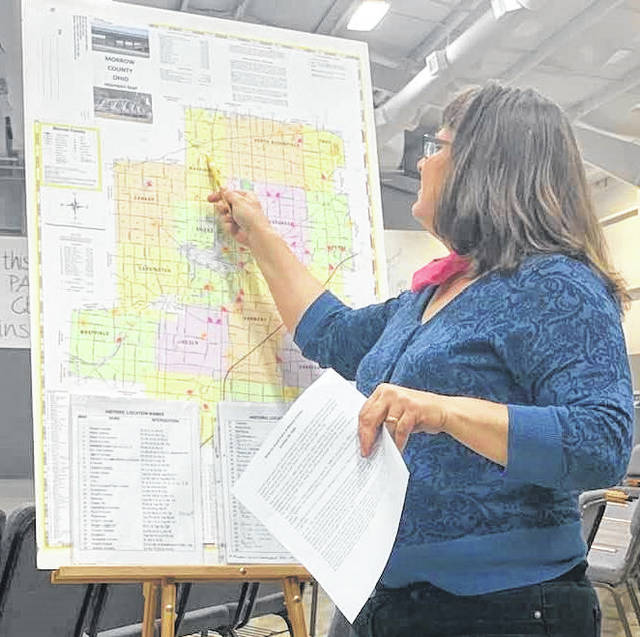WASHINGTON TOWNSHIP — One was a thriving company town with very little remnants, some had several names and quite a few others existed only on paper.
These “Ghost Towns of Morrow County” was the subject of a presentation by the Morrow County Genealogical Society Oct. 24.
“We count 57 ghost towns on the list,” said Dan Rhodebeck, who along with Ann Artrip, has spent hours researching the now forgotten communities.
Railroad influence
“Right now we are in St. James — or very near it — right down the road two-tenths of a mile,” Artrip said at the meeting held at Open Arms Christian Church on State Route 61.
St. James came about because of the railroad industry, namely The Cleveland, Columbus and Cincinnati Railroad.
“In 1851 it was Iberia Station and later in 1890 it became St. James,” Artrip said. It was also known as Haywood or Harwood in the late 1880s.
The town had a half-dozen houses, a general store and a train station; later a grain elevator was built. Today just a handful of houses and an empty junkyard remain.
‘Paper towns’
“Paper ghost towns are those that never materialized,” said Artrip, who serves as president of the society.
An example is York, platted in 1849 by Daniel and Mary Flint at the intersection of State Route 61 and Township Road 49. Another in the same township was Port Miller platted by Samuel G. and Nancy J. Miller in 1852 near the CCC railroad and CR 59.
Port Miller was a proposed town with 47 lots, but no further record exists of it.
Rhodebeck noted the county recorder’s office is where plats of land were recorded. ”You can find these little towns that were laid out.”
Quite a Surprise
“My favorite ghost town is Surprise,” Artrip said. “I grew up near it.”
Her great, great grandmother was there when “a group of men were in the room talking about naming the town. One of the women came in and learned of this and said, ‘That will be a surprise won’t it?’”
The name stuck.
At its peak, Artrip said, Surprise had the one-room Davis Schoolhouse and a handful of homes.
Various names
Before it became Edison, the town was known as West Gilead, Levering and Gilead Station.
“It was a rough place with gambling and drinking,” Artrip said. Luther Mozier, who owned the land, sold it because he didn’t approve of that type of behavior.
Mozier built the first house in the village and also erected several other buildings.
In 1881 it was changed to Edison, which still exists with several businesses and 437 residents, per the 2010 U.S. Census.
Thriving Tidewater
“This was a company town with nice brick homes,” said one longtime resident.
Tidewater Pumping Station was built there around 1900. It was one of a series of pumping stations from oil fields ranging from Texas to the east coast.
Oil played a key role in Canaan Township’s history. Tidewater closed when the pipeline was torn up and the pumping station abandoned in 1945.
John G. Clark purchased the station and buildings and a box factory was built, with 175 employees. It was sold in 1975 to Field Container Corporation and the operations later moved to Marion.
Very little evidence is visible today of the once busy burg.
Many ‘Corners’
Rhodebeck listed a number of towns with the name corners in them including:
Bartlett’s Corners, Burn’s Corners, Center Corners, Grays Corners, Shade’s Corners, Elm Tree Corners, Ogle’s Corners, Schaff’s Corners, Ruhl’s Corners, Burr’s Corners/Fritz Corners, Jackson Corners, Rose’s Corners, Beck’s Corners and Owl Roost Corners.
“In the late 1800s there were neighborhoods and little towns that were important before roads and house numbers were used,” Rhodebeck said.
These neighborhoods, often with just a few inhabitants, were named after families with Corners attached.
“Some, like Shade’s Corners, are still used today,” he said.
News from Owl Roost
Owl Roost Corners sat at the intersection of Township Roads 21 and 220, northeast of Marengo in Bennington Township.
“Mary McCurdy did news from Owl Roost for many years,” Rhodebeck said.
Many small communities contributed reports to the area’s newspapers. Some reported obituaries of its residents.
“These correspondents had a deeper knowledge of the communities,” he said. They wrote about family gatherings and visits.
Four types
There are true ghost towns, with some remnants even just a cemetery; semi ghost towns, like St. James; paper ghost towns that never existed and old towns that changed their character or name.
Philip Varney, the author of several popular ghost town books, defines these old communities as “any site that has had a markedly decreased population from its peak, a town whose initial reason for settlement (such as a mine or railroad) no longer keeps people in the community.”
Some towns, such as North Woodbury acquired a second name. In this case it was also known as Woodview because of the post office by that name, Rhodebeck said.
More towns
• Benedict Mills, Peru Township, first cabin in 1810 near Alum Creek.
• Florida Grove, Franklin Township, established 1823; failed by 1880.
• Jamestown, Franklin Township, 1825 possibly also known by Kelly’s Corners.
• McEwen’s Crossroads, Troy Township, first mills built in 1815 at State Routes 314 and 97; gone by 1864.
• Rome, South Bloomfield Township, surveyed in 1827.
• Shawtown, Westfield Township, existed around 1814.
• Vail’s Crossroads, Bennington Township, established 1850; gone by 1873.
Some names were added after residents attended the Morrow County Fair and gave their input based on family information. Newspaper records also turned up Turners Corners and Veil’s Corners, which is near Sparta.
Other interesting names include:
8 Square, Turney Center, Blackbird, Frozen Hill, Beggar Louise Hill, Petersburg, Bungtown, Rail Fence, Hollywood, Little Chicago, Chambersburg, Bowen Corners, Mead Corners, Long Corners, Jug’s Corners.







